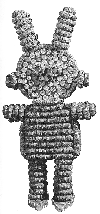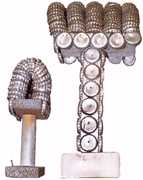
 A remarkable level of obsession can be found in the bottle-cap world created by
Clarence and Grace Woolsey. The many objects they made -- one using at least
30,000 caps -- became, after their deaths, among the most significant
folk/outsider art discoveries of the decade.
A remarkable level of obsession can be found in the bottle-cap world created by
Clarence and Grace Woolsey. The many objects they made -- one using at least
30,000 caps -- became, after their deaths, among the most significant
folk/outsider art discoveries of the decade.
Their legacy includes a full-size bicycle made of caps, bottle-cap-encrusted
 figures several feet high that resemble aliens, bunnies and other creatures;
small buildings in which strands of bottle caps serve as walls; wind mills;
tepees; and a miscellany of small objects (the exact number is uncertain but
likely to be 200 or more). The pieces do not look much like any of the usual
figures or baskets, reflecting a vision of the decorative and architectural uses
of bottle caps entirely the Woolsey's.
figures several feet high that resemble aliens, bunnies and other creatures;
small buildings in which strands of bottle caps serve as walls; wind mills;
tepees; and a miscellany of small objects (the exact number is uncertain but
likely to be 200 or more). The pieces do not look much like any of the usual
figures or baskets, reflecting a vision of the decorative and architectural uses
of bottle caps entirely the Woolsey's.
"Little did I believe they would be of such scale, such detail and such
imagination," says Iowa antiques dealer Tom Van Deest, describing his first
reaction to the Woolsey pieces, a number of which passed through his hands.
The Woolseys, farmhands who lived near Lincoln, Iowa, reportedly started
producing their art one snowy night in 1961 in an attempt to make use of a
gallon of bottle caps they had accumulated. By the early '70s, according to
information supplied by Paula and Tom Van Deest, they were showing their
bottle-cap menagerie publicly as the World's Largest Pioneer Caparena and
charging 25 cents admission. Public interest proved limited, however, and the
Caparena wound up in a barn owned by Grace Woolsey's brother.
When Clarence Woolsey died in 1987 and Grace in 1992, their achievement
had been mostly forgotten. In May 1993, however, Grace's brother's farm
went to auction in one of those stories of which collectors and dealers dream.
A handful of dealers bid at the auction, on what they were not sure, according
to an article in the Maine Antique Digest.
The entire Woolsey collection fetched $57. During the first two years in
which the figures worked their way through the folk art/antiques market,
the large pieces broke $5,000, and even the smallest reached
$100 or more.
Tom Van Deest estimated in 1994 that only seven Woolsey pieces were left
in Iowa: "It came through and it just disappeared," he says. "It was sucked out,
like a vacuum cleaner went through."
In the years that followed even those left the state, along with a flow of Woolsey-inspired pieces made by people who bought up the couple's leftover bottle caps. Some of those recent constructions were sold for what they were: Sculptures in the spirit of Clarence and Grace. Others, however, entered the market as counterfeits. Anyone buying a large-scale Woolsey piece should closely examine its provenance.
In any case, the Woolseys shared with the anonymous crafters of most bottle-cap sculpture both obscurity and that distance from the art world that excites folk-art collectors' enthusiasm.
|

